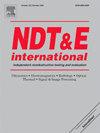Reverse time migration damage morphology reconstruction algorithm based on laser ultrasonic circular sensing array
IF 4.1
2区 材料科学
Q1 MATERIALS SCIENCE, CHARACTERIZATION & TESTING
引用次数: 0
Abstract
In response to the quantitative detection needs of damage in large metal thin-walled structures, this paper uses laser ultrasonic detection technology to excite and collect ultrasonic waves, and improves the traditional reverse time migration imaging algorithm to achieve the goal of reconstructing damage morphology. By analyzing the acoustic scattering characteristics, the theoretical basis was provided for damage reconstruction based on circular sensing arrays, and algorithm improvements were made to the traditional time reversal based reverse time migration imaging technology(TR-RTM) in terms of scattered wave extraction and reconstruction accuracy evaluation. We have built a laser ultrasonic detection platform and achieved accurate reconstruction of regular damages such as circles, triangles, and squares based on array wavefield data. However, for irregular damages with dents and sharp corners, we can only reconstruct their approximate contours and analyzed the reasons that limit imaging accuracy. This study laid a theoretical and experimental foundation for the quantitative assessment of damage.
基于激光超声圆形传感阵列的逆时偏移损伤形态重建算法
针对大型金属薄壁结构损伤的定量检测需求,本文采用激光超声检测技术对超声波进行激发和采集,并对传统的逆时偏移成像算法进行改进,达到重建损伤形态的目的。通过分析声散射特性,为基于圆形传感阵列的损伤重建提供理论依据,并对传统基于时间反演的逆时偏移成像技术(TR-RTM)在散射波提取和重建精度评价方面进行了算法改进。我们搭建了激光超声检测平台,基于阵列波场数据实现了圆形、三角形、正方形等常规损伤的精确重建。而对于带有凹痕和尖角的不规则损伤,我们只能重建其近似轮廓,并分析了限制成像精度的原因。本研究为损伤定量评估奠定了理论和实验基础。
本文章由计算机程序翻译,如有差异,请以英文原文为准。
求助全文
约1分钟内获得全文
求助全文
来源期刊

Ndt & E International
工程技术-材料科学:表征与测试
CiteScore
7.20
自引率
9.50%
发文量
121
审稿时长
55 days
期刊介绍:
NDT&E international publishes peer-reviewed results of original research and development in all categories of the fields of nondestructive testing and evaluation including ultrasonics, electromagnetics, radiography, optical and thermal methods. In addition to traditional NDE topics, the emerging technology area of inspection of civil structures and materials is also emphasized. The journal publishes original papers on research and development of new inspection techniques and methods, as well as on novel and innovative applications of established methods. Papers on NDE sensors and their applications both for inspection and process control, as well as papers describing novel NDE systems for structural health monitoring and their performance in industrial settings are also considered. Other regular features include international news, new equipment and a calendar of forthcoming worldwide meetings. This journal is listed in Current Contents.
 求助内容:
求助内容: 应助结果提醒方式:
应助结果提醒方式:


